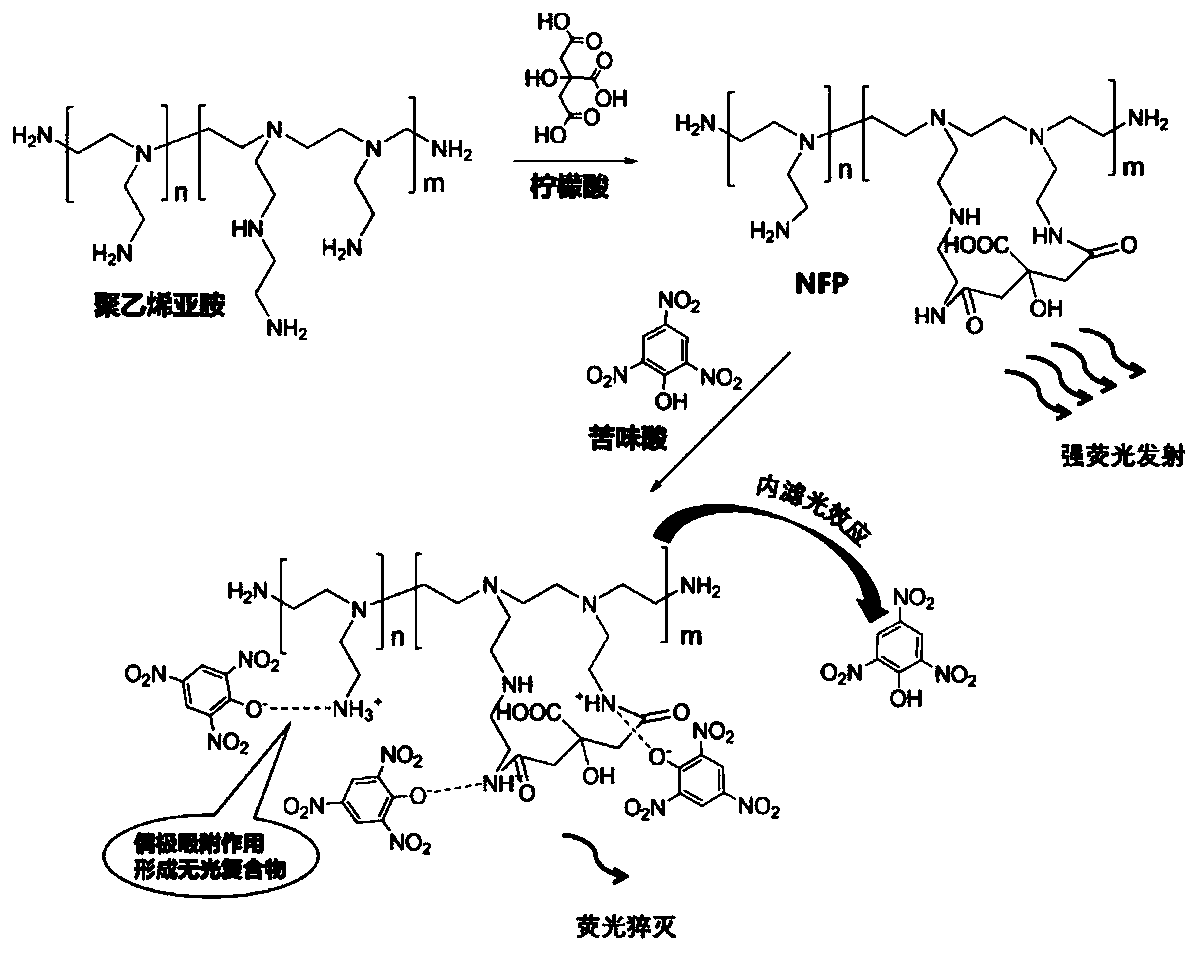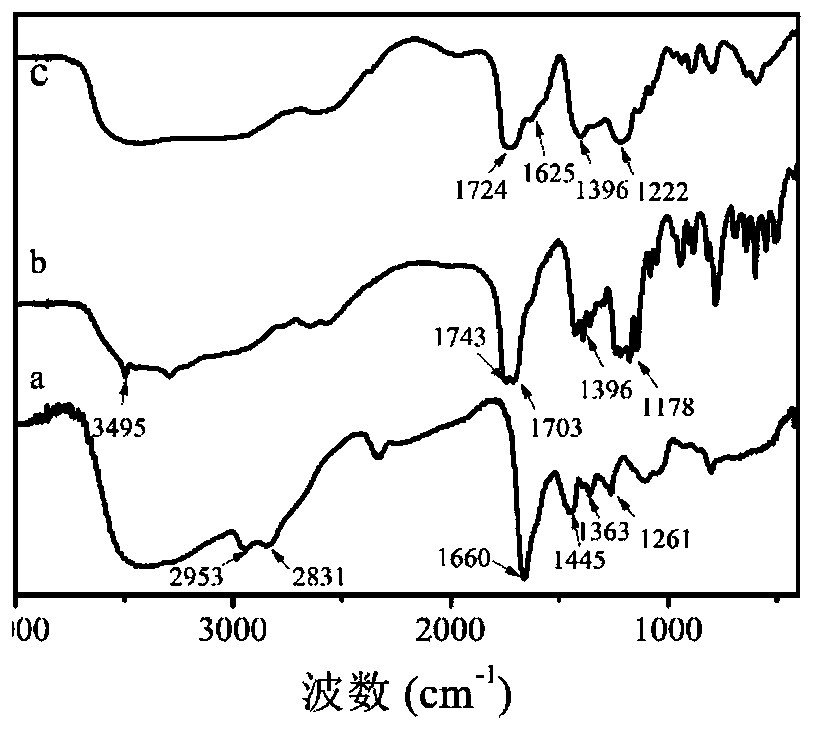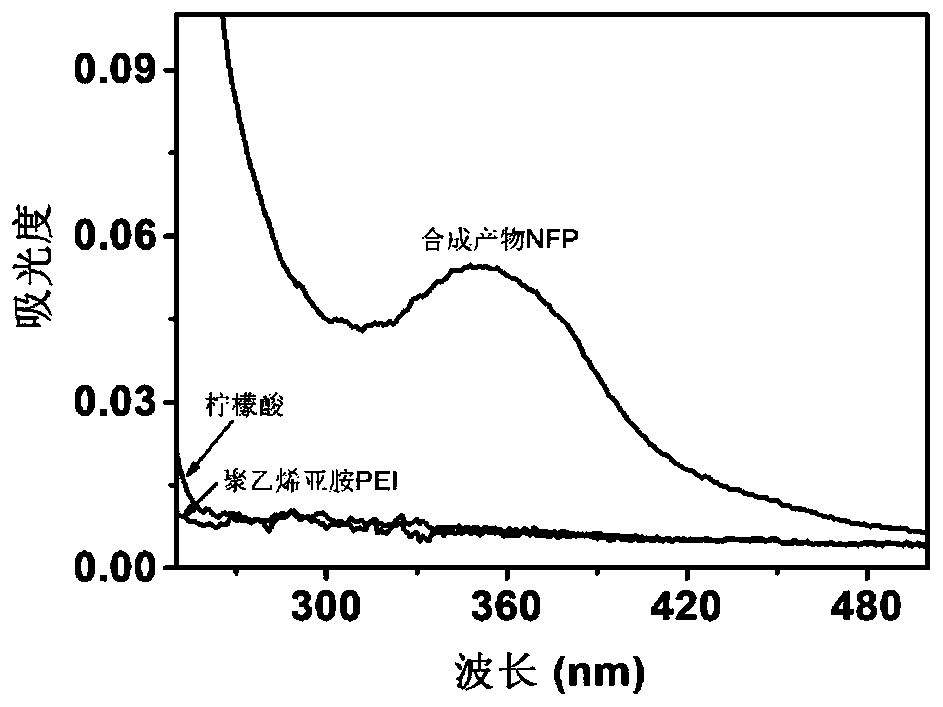Preparation method of non-conjugated fluorescent polymer and application thereof in picric acid detection
A fluorescent polymer, non-conjugated technology, applied in the direction of fluorescence/phosphorescence, chemical instruments and methods, luminescent materials, etc., can solve the problems of poor selectivity, low sensitivity, cumbersome synthesis steps of fluorescent probes, etc. Good solubility, good water solubility, and mild preparation conditions
- Summary
- Abstract
- Description
- Claims
- Application Information
AI Technical Summary
Problems solved by technology
Method used
Image
Examples
Embodiment 1
[0037] A method for preparing a non-conjugated fluorescent polymer, comprising the following steps:
[0038] Mix 400μL of 1g / L PEI and 8mL of 0.05M citric acid into the Erlenmeyer flask, then add water to 40mL, heat and stir the mixed solution at 70°C for 8h, and obtain the product of polymer NFP with strong fluorescence emission solution, the product solution was put into a dialysis bag with a molecular weight cut-off of 3500Da and dialyzed for 6 hours, using ultrapure water as the dialysate to remove unreacted small molecule citric acid, collecting the solution in the dialysis bag, concentrating it, and drying it for later use. That is, a non-conjugated fluorescent polymer material (NFP) is obtained.
[0039] The product that present embodiment obtains carries out the characterization of ultraviolet, infrared and fluorescence spectrum respectively, and the result is as follows:
[0040] Infrared characterization as figure 2 As shown, a, b, and c in the figure represent th...
Embodiment 2
[0044] Application of the non-conjugated fluorescent polymer prepared in Example 1 in the quantitative detection of picric acid
[0045] The detection method of described picric acid comprises the following steps:
[0046] (a) Prepare a series of aqueous solutions containing non-conjugated fluorescent polymers obtained in Example 1 containing different concentrations of picric acid, use 10mM phosphate buffer solution to adjust the pH of each system to 8.5, and place it at room temperature for 5min, use HitachiF- 4500 fluorescence spectrophotometer, under the excitation wavelength of 360nm and the excitation and emission slit of 10.0nm, test the fluorescence spectrum diagram of each system, such as Figure 5 , 6 As shown, it can be seen from the figure that when picric acid is added to the system, the fluorescence intensity of the NFP polymer with strong fluorescence emission decreases gradually, and the degree of fluorescence decrease increases with the increase of the amount...
Embodiment 3
[0050] Optimization of the pH of the detection system in the application of non-conjugated fluorescent polymers in the quantitative detection of picric acid
[0051] Prepare 0.16g L -1 The aqueous solution of the non-conjugated fluorescent polymer obtained in Example 1 containing 50 μM picric acid, using 10 mM phosphate buffer solution to adjust the pH of each system to 4.2, 5.3, 5.72, 6.0, 6.5, 7.0, 7.4, 8.0, 8.5, 9.1, 10.0, 10.5, and placed at room temperature for 5 minutes, using a Hitachi F-4500 fluorescence spectrophotometer, under the excitation wavelength of 360nm and the excitation and emission slit of 10.0nm, the fluorescence spectra of each system were tested, and the pH is the abscissa, before and after adding picric acid, the fluorescence quenching value of the system at 450nm is plotted on the ordinate, as Figure 8 As shown, it can be seen from the figure that the pH value will affect the degree of fluorescence quenching of picric acid to NFP, and when the pH of...
PUM
 Login to View More
Login to View More Abstract
Description
Claims
Application Information
 Login to View More
Login to View More - R&D
- Intellectual Property
- Life Sciences
- Materials
- Tech Scout
- Unparalleled Data Quality
- Higher Quality Content
- 60% Fewer Hallucinations
Browse by: Latest US Patents, China's latest patents, Technical Efficacy Thesaurus, Application Domain, Technology Topic, Popular Technical Reports.
© 2025 PatSnap. All rights reserved.Legal|Privacy policy|Modern Slavery Act Transparency Statement|Sitemap|About US| Contact US: help@patsnap.com



